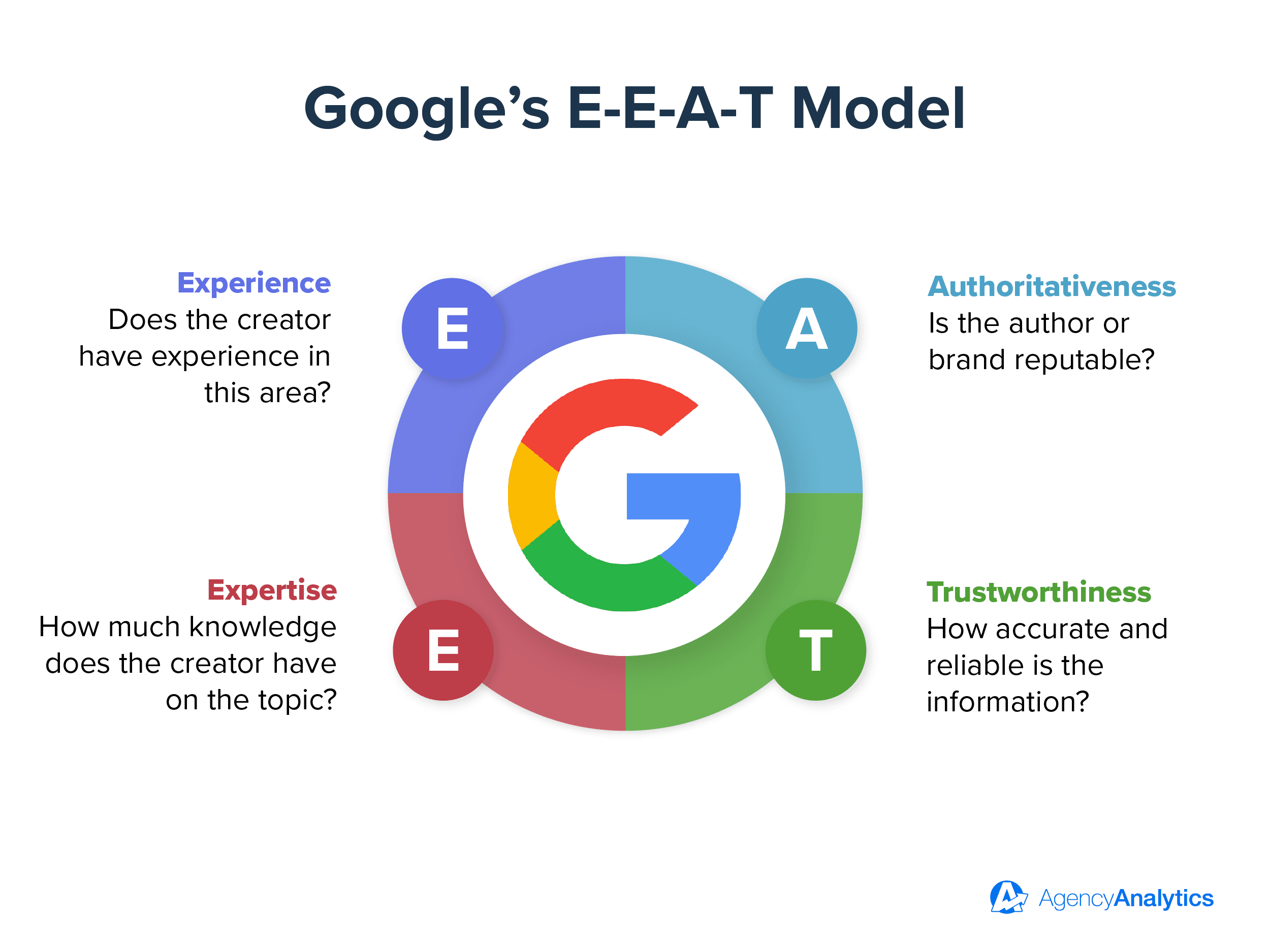Table of Contents
QUICK SUMMARY:
Building a Voice of the Customer (VoC) program is a smart strategy for enhancing the authority of your client’s content for improved search engine performance. This article reveals best practices for extracting VoC insights based on successful methods used at AgencyAnalytics. Read on to learn how to harness VoC data to optimize your clients’ digital content and use this knowledge to elevate your agency’s content too.
Imagine you’re on the hunt for a time-tracking tool for your agency. You come across one provider whose feature-heavy website is loaded with technical jargon.
Unimpressed, you look up another provider. This time, the messaging clicks: “Struggling to track team productivity?” “Tired of inefficient workflows?” The relatable language resonates instantly. You dig into the website’s resources section to find a library of helpful content on topics like improving team processes and maximizing billable hours.
In a matter of just a few minutes, provider B seems like the obvious choice. This example demonstrates the power of speaking in the Voice of the Customer (VoC).
Using the Voice of the Customer is a powerful way to build trust, authority, and credibility—key factors driving customer action. With Google tightening its content standards to give more visibility to authoritative content, agencies are pressured to move beyond generic, AI-generated material and create authentic content that checks all the boxes.
In this article, we’ll cover a few methods and best practices for extracting the Voice of the Customer and share some approaches to integrating these insights into your clients’ content for better search visibility.
What Is Voice of the Customer (VoC)?
Voice of the Customer (VoC) is the practice of gathering customer feedback and customer experiences through a series of qualitative and quantitative market research methods. The goal is to evaluate and leverage these perspectives to improve the customer journey.
Some of the benefits of building Voice of the Customer programs include:
Refining Messaging and Tone
Voice of the Customer research methods extract the language customers use to describe their challenges and customer pain points. Echoing this same language in your clients’ marketing copy is a surefire way to create content that speaks directly to their ICP and improves engagement potential.
Enhancing Customer Personalization
Voice of the Customer insights help you break down customer segments for extra personalization. You might find that all customers share a common pain point, but depending on their niche, the implications of this pain point look different. Further segmenting your client’s customers is a way to develop more thoughtfully targeted campaigns.
Building Customer Loyalty
Building a Voice of the Customer program is an excellent way to maximize customer retention rates by quickly responding to customer expectations. Collecting customer feedback and making necessary product or service improvements shows your clients’ customers that they care about customer needs.
Enhancing Search Engine Performance
When it comes to content creation, gaining a deep understanding of customer needs makes you more skilled at speaking their language across all digital marketing materials. This tactic builds trust and gives your client a better chance at aligning with Google’s E-E-A-T framework, which assesses the quality of website content. Let’s take a closer look.
How Does the Voice of the Customer Influence Search Engine Rankings?
Google’s E-E-A-T framework is a set of rules that Google uses to assess the value of web pages in delivering practical, authoritative, and reliable information to online audiences.
Here’s a breakdown of what the acronym stands for and what Google assesses content for:
Experience: Evaluates whether the content creator has firsthand or personal experience with the topic.
Expertise: Assesses the level of knowledge or expertise the content creator has on the subject matter.
Authoritativeness: Measures the content creator’s reputation or authority in the field and whether or not it appears to be a go-to source of information.
Trustworthiness: Gauges the content's overall reliability, accuracy, and honesty.

By gathering and analyzing direct customer feedback through a Voice of the Customer program, you set yourself up to create content that reflects genuine customer Experiences, demonstrating Expertise in solving real issues and establishing Authoritativeness in your client’s industry. Addressing customer concerns and using the specific words, phrases, and language customers use helps make the content more relatable and Trustworthy.
Firsthand Insights Boost Content Experience Scores
Interviewing people who have firsthand experience with a product allows you to fill client content with authentic insights, real-life use cases, and relatable stories, all aligning closely with Google's E-E-A-T framework for Experience. This demonstrates that content is grounded in real-world usage and practical understanding and is informed by direct, experiential knowledge rather than theoretical or secondhand information.
Professional Insight Improves Content Expertise Scores
Search engines reward high-quality content featuring in-depth, reliable information. Inviting industry experts to author blog content for clients is one way to strengthen the value of your clients’ content in Google’s eyes. Asking a veterinarian from your client’s clinic to write on tooth decay in dogs, for example, showcases firsthand knowledge on the topic. This enhances the Expertise component of the Google E-E-A-T score.
Using Industry-Specific Language Builds Content Authoritativeness Scores
The beauty of building a Voice of the Customer program is that you’ll often end up gathering the specific language, terms, and phrasing that the audience uses every day. Incorporating this language into your clients’ content helps them demonstrate their deep understanding of customer challenges. This builds the client’s Authoritativeness rating, demonstrating to Google that the content is created by knowledgeable and credible people in the field.
Addressing Customer Concerns Enhances Content Trustworthiness Scores
A strong VoC program helps you discover the biggest customer pain points. The next step is creating content that directly addresses these challenges.
Let’s say that your client’s customer base of accountants struggles with time management during tax season. Use this insight to propose a blog strategy featuring pillar posts on the topic. This customer-centric content will appear trustworthy and reliable, helping you improve the Trustworthiness component of the E-E-A-T score.
How To Extract Voice of the Customer Insights for Content Optimization
Here are five ways to gather helpful VoC data, plus some best practices for ensuring you get the most out of each of these methods.
1. Customer Surveys
Surveys are efficient ways to collect customer feedback from a large number of existing customers. Run these by creating pop-up surveys on your clients’ websites or by emailing surveys to their subscriber lists.
There’s so much more to this strategy than sending out mass customer satisfaction surveys and waiting for customer complaints or positive feedback! Be sure to design survey questions that will give you valuable answers to act on. Don’t be afraid to dive deep into specific topics that reveal the nuances of your audience’s challenges and their specific customer expectations.
We recommend wrapping up each survey by asking your clients’ customers if they’d be interested in furthering the conversation. Scoping out their appetite for further involvement screens them as potential candidates for one-on-one customer interviews.

At AgencyAnalytics, we send out a weekly series of insight surveys, asking our audience about their personal experiences. The answers we collect allow us to add unique quotes–you’ll even find some of them throughout this article. The result is richer, more thoughtful blog content that addresses the challenges of our Ideal Customer Profile (ICP) in their own words.
The impact of this VoC initiative is even more evident when we notice contributors sharing the articles where they are featured on their LinkedIn profiles, highlighting their involvement and extending the post’s reach and authenticity within their network.
2. One-On-One Customer Interviews
One-on-one interviews are our favorite way to gather in-depth and direct customer feedback. The open-format discussion gives your team the freedom to ask immediate follow-up questions and dig deeper to further understand the customer experience. The beauty of customer interviews is that they offer your agency a chance to capture the emotional nuances behind customer decisions, frustrations, and customer preferences.
Make sure that you’re asking open-ended questions, like:
"Can you walk me through a specific situation where our product/service helped you solve a problem? What stood out to you?"
"What challenges or frustrations did you face before using our product/service, and how has that changed since you started using it?"
"Are there any features or aspects of the product/service that you feel could be improved or that didn't meet your expectations? If so, how?"
"How would you describe our product/service to a colleague in your own words? What key benefits would you highlight?"
"Is there anything we could have done differently to improve your experience, either during or after your purchase?"
Another piece of advice is to record the interviews to ensure you capture exact quotes and language to integrate into your clients’ content.
AgencyAnalytics’ Agency Profile series welcomes interested clients to participate in a 60-minute interview with a member of our content team. We then turn these discussions into editorial articles highlighting the client’s journey and further leverage the recorded video content on social media.
Even though we think of ourselves as content marketing experts, our customers are the ones who live and breathe the topics we write about on our blog. Whether we’re talking about optimizing paid ad campaigns, dealing with client requests, or managing scope creep, they’re often the best possible source of information for our articles.
By sharing in-depth stories and perspectives, these pieces offer relatable insights into the challenges and successes of running an agency, creating truly unique content.

3. Guest Blog Posts
A fantastic way to beef up your clients’ content is to invite their customers (or industry experts in their niche) to share their perspectives on your clients’ platforms. Asking your clients’ customers to contribute as guest authors opens up the opportunity to gather unique perspectives that add credibility to your clients’ content while aligning with industry trends.
At AgencyAnalytics, some of the most unique and interesting articles we publish come from experts who started by providing survey responses, and then were eager to take their involvement further.
An example of a resulting article is Jessica Tappana’s A Therapist-Turned-Agency Owner’s Guide To Stress Management. This post, written by the founder of marketing agency Simplified SEO, is packed with the author's firsthand experiences, offering our audience practical advice grounded in real-life scenarios.
4. Social Media & Online Forums
Monitoring social media platforms and online forums like Reddit is another effective way to gather online reviews to act on. Hootsuite, Sprout Social, or Bandwatch are handy social listening tools for tracking relevant keywords, mentions, and hashtags.
These platforms are a goldmine for unfiltered customer complaints and comments about their preferences, giving you full visibility into how customers naturally talk about your clients’ brands.
When people ask questions on social media, or via email, we write articles to answer the question and grow our content pieces. We figure if someone is asking for it, there are at least 10 other people thinking about the same question.
Ruben Roel, President / Founder, Investigator Marketing
Let’s say you monitor Reddit to discover that many of your clients’ customers struggle with a particular software feature. It would be wise to then create a series of blog posts or FAQs to provide step-by-step instructions. Weave in the specific phrases, expressions, or terminology customers use to help them feel understood.

Turn customer feedback into opportunities you can act on. Gather customer reviews for your clients using AgencyAnalytics’ Facebook or Google Business Profile integrations and turn them into digestible reports. Try it free for 14 days.
5. Customer Support Feedback
Customer inquiries and support forms are also great tools for identifying customer pain points. Use responses from post-purchase surveys, product reviews, and customer service transcripts as opportunities for content ideation. From there, craft content that explains how customers can realize the product’s benefits.
At AgencyAnalytics, we compile tips directly from marketing agency professionals who use our platform daily and turn this into helpful content. Our insiders share their firsthand experiences, offering valuable advice on leveraging reporting tools for maximum client impact.
Whether you plan to start with just one of these Voice of the Customer research methods or use a mix of them from the start, be sure to analyze customer data carefully to identify gaps in your client’s content. Then, create, optimize, or re-work content, weaving in the feedback you’ve received to enhance your clients’ marketing strategies.
Don’t Forget To Build a Voice of The Customer Program for Your Agency, Too
It’s all too easy to invest time into VoC programs for your clients only to overlook doing the same thing for your own agency. Here are a few ways to leverage VoC tactics for your agency’s success as well:
Create Social Proof Assets
One of the biggest wins of Voice of Customer research is that you often end up with fantastic materials for case studies or testimonials. The fun part is taking the stories you’ve captured in client interviews and turning them into narratives showcasing how your agency solved the client’s biggest challenges.
If you only have time to implement one or two tactics for your own agency, we recommend turning positive feedback into social-proof copy that adds to your agency’s credibility. Extract client stories for testimonials on your agency websites or pitch deck.
Better yet, consider adding client quotes to your blog content, like we do! Our long list of case studies showcases our clients’ successes as a result of using the AgencyAnalytics platform.

Hire Industry Experts for Complex Client Niches
One way to deeply immerse yourself in your client niche is to hire industry experts who already live, breathe, and speak the language of your clients.
Simplified SEO Consulting, an agency that supports a client base of counseling practitioners, hires talent who are psychology experts first and then trains them in marketing.
This unique top-down hiring strategy allowed the agency to build a team equipped with firsthand experience and understanding of the intricacies of running therapy practices. Expert team members also fluently speak the terms and language that resonate with the agency’s ICP.
We hire people with education in mental health, generally, not digital marketing. Everybody we hire has a bachelor's or master's degree in psychology, social work, or a closely related field. It really sets us apart because we know the field well.
Jessica Tappana, Founder, Simplified SEO Consulting
In another example, Terrayn, a cannabis and CBD marketing agency, hired an account manager who previously owned a Cannabis dispensary, tapping into his deep knowledge of the challenges involved in navigating a highly specialized niche market.
It’s a huge differentiator for us. Even for some of our team members who maybe don’t have that operational experience, they learn from the folks that have. They’ll say, ‘Can you help my client because they’re struggling with this operational challenge.’ They know what the client’s challenges are, even if it was a year or two ago. They can say things like ‘When I struggled with this three years ago when I ran a dispensary, this is how we solved it.’ We’ve always looked for people with industry knowledge.
Trevor Shirt, CEO, Terrayn
The Takeaway
Making a commitment to gathering direct feedback and insights has been a monumental move at AgencyAnalytics. Each step on our VoC journey reinforced the commitment to authentic, customer-driven content, setting a new standard in our company’s content strategy that we’re proud of today.
Incorporating a Voice of the Customer program into your content strategies not only aligns your clients’ content with customer needs; it also helps your team create distinctive content that’s relevant, engaging, and highly optimized to drive measurable SEO results.
Take your strategy one step further and track the success of your content marketing efforts with AgencyAnalytics. Measure your SEO impact with a custom AgencyAnalytics dashboard based on the metrics you want to see most. Try it free for 14 days.

Written by
Sylva is an expert content writer with over 10 years of experience in tech and SaaS, offering first-hand insight into agency needs from her background in advertising.
Read more posts by Sylva SivzattianSee how 7,000+ marketing agencies help clients win
Free 14-day trial. No credit card required.





